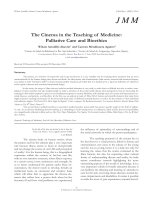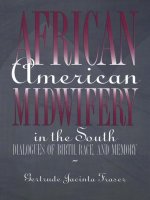The Golf Course Planning, design, construction and maintenance ppt
Bạn đang xem bản rút gọn của tài liệu. Xem và tải ngay bản đầy đủ của tài liệu tại đây (6.84 MB, 226 trang )
The Golf Course
Planning, design, construction and maintenance
JOIN US ON THE INTERNET VIA WWW, GOPHER, FTP OR
EMAIL:
WWW: http://
www.thomson.com
A service of
GOPHER: ghopher.thomson.com
FTP: ftp.thomson.com
EMAIL:
m
OTHER TITLES FROM E & FN SPON
Amenity Landscape
Management
A resources handbook
R.Cobham
Countryside Conservation
3rd Edition
B.Green
Countryside Management
P.Bromley
Countryside Recreation
Access and land use
planning
N. Curry
Countryside Recreation
A handbook for managers
P.Bromley
Design for Outdoor
Recreation
S.Bell
Grounds Maintenance
A contractor’s guide to
competitive tendering
P.Sayers
Leisure and Recreation
Management
3rd Edition
G.Torkildsen
Managing Sport and
Leisure Facilities
A guide to competitive
tendering
P.Sayers
Recreational Land
Management
2nd Edition
W.Seabrooke and C.Miles
Spon’s Grounds
Maintenance Contract
Handbook
R.Chadwick
Spon’s Landscape
Contract Manual
A guide to good practice and
procedures in the
management of landscape
contracts
H.Clamp
Spon’s Landscape
Handbook
4th Edition
Derek Lovejoy & Partners
Spon’s Landscape and
External Works Price Book
Published annually
Derek Lovejoy and Partners
and Davis Langdon &
Everest
Sports Turf
Science, Construction and
maintenance
V.I.Stewart
For more information on these and other titles please
contact: The Promotion Department, E & FN Spon, 2–6
Boundary Row, London, SE1 8HN. Telephone 0171–865
0066.
ii
The Golf Course
Planning design,
construction and
maintenance
F.W.Hawtree
E & FN SPON
An Imprint of Chapman & Hall
London · Weinheim · New York · Tokyo ·
Melbourne · Madras
Published by E & FN Spon,
and imprint of
Chapman & Hall, 2–6
Boundary Row, London SE1
8HN,
UK
Chapman & Hall, 2–6
Boundary Row, London SE1
8HN, UK
Chapman & Hall GmbH,
Pappelallee 3, 69469
Weinheim,
Germany
Chapman & Hall USA., 115
Fifth Avenue, New York, NY
10003, USA
Chapman & Hall Japan, ITP-
Japan, Kyowa Building, 3F,
2–2–1 Hirakawacho, Chiyoda-
ku, Tokyo 102, Japan
Chapman & Hall Australia,
102 Dodds Street, South
Melbourne, Victoria 3205,
Australia
Chapman & Hall India,
R.Seshadri, 32 Second Main
Road,
CIT East, Madras 600 035,
India
First edition 1983
ISBN 0-203-99257-1 Master e-
book ISBN
ISBN 0 419 12250 8 (Print
Edition)
Apart from any fair dealing for
the purposes of research or
private study, or criticism or
review, as permitted under the
UK Copyright Designs and
Patents Act, 1988, this
publication
may not be reproduced, stored,
or transmitted, in any form or
by any means, without the
prior permission in writing of
the
publishers, or in the case of
reprographic reproduction only
in
accordance with the terms of
the licences issued by the
Copyright Licensing Agency in
the UK, or in accordance with
the terms of licences issued by
the appropriate Reproduction
Rights Organization outside
the UK. Enquiries concerning
reproduction outside the terms
stated here should be sent to
the publishers at the London
address printed on this page.
The publisher makes no
representation, express or
implied,
with regard to the accuracy of
the information contained in
this book and cannot accept
any legal responsibility or
liability
for any errors or omissions
that may be made.
A Catalogue record for this
book is available from the
British
Library
Library of Congress Cataloging-
in-Publication Data
Hawtree F.W. (Fred W.)
The golf course
Bibliography:p
Includes index.
1. Golf course—Design and
construction.
2. Landscape architecture. I.
Title.
GV975. H39 1983 796.
352’06’8 82–19143
ISBN 0-419-12250-8 (Print
Edition)
iv
This edition published in the
Taylor & Francis e-Library,
2005.
“To purchase your own copy of
this or any of Taylor & Francis
or Routledge’s collection of
thousands of eBooks please go
to
www.eBookstore.tandf.co.uk.”
© 1983 F.W.Hawtree
v
Contents
Foreword viii
Acknowledgements ix
1 Introduction 1
2 Philosophy 5
2.1 The formative years 5
2.2 The Middle Age 32
2.3 Transition 38
2.4 Lessons 43
3 Planning 49
3.1 The site 49
3.2 Layout 52
3.3 Guidelines 58
3.4 Rehearsal 61
3.5 Short alternatives 64
4 Design 67
4.1 Tees 67
4.2 Putting greens 89
4.3 Bunkers 112
4.4 Fairways and rough 121
4.5 Trees 124
4.6 Water 136
5 Construction 141
5.1 Method 141
5.2 Specification 145
5.3 Bills of Quantity 147
5.4 Drawings 149
5.5 Clerk of Works 150
6 Practical politics 153
6.1 The head greenkeeper 153
6.2 Etiquette 156
6.3 Safety 159
6.4 Furniture 160
6.5 Presentation 163
6.6 A single green 168
Appendix 1 Survey of the carry (pitch) of drives
carried out on behalf of the British
Association of Golf Course
Architects (B.A.G.C.A.)
173
Appendix 2 Length/area guide 175
Appendix 3 Green plans (Martin G.Hawtree) 177
Appendix 4 Specimen pages: Specification and
Bills of Quantity
183
Appendix 5 Tree lists 193
Appendix 6 Metric/Imperial conversions 203
Bibliography 205
Index 207
vii
Foreword
Henry Cotton MBE
At the start, I must tell the reader that this book is a
detailed, interesting study of how to design and build a
golf course—a complex business.
The author’s father entered golf course design through
greenkeeping and in the 1920s joined up with that great
golfer, J.H.Taylor. Theirs were some of the first modern
inland courses, away from the links where Nature had
already prepared the way. I particularly remember some of
that original planning, with island greens completely
surrounded by a ring of sand-traps, obliging golfers to
approach by the all-air route and calling for nominated
shots.
The present Fred Hawtree (son of Hawtree I) and his son,
Martin, have carried on the practice of golf course
architecture, living with golf and doing their work with
skill and good taste. This book will help golfers and
officials to improve their personal ideas on layout,
especially those with low handicaps and their own
interests at heart.
There are many amateur golf course architects who seek
to alter holes they dislike; some I have known have even
become golf club officials in order to fill in a hazard which
regularly collects one of their shots. In the face of such
pressures, Hawtree courses (and they have owned one as
well as designed hundreds) are fair but never easy to
handle.
Fred Hawtree ‘knows his stuff and this book is a classic.
Portimao
January 1983
Acknowledgements
The sources of conscious quotations are, I hope, all
acknowledged in the text but some deserve special
mention.
The Game of Golf, by Willie Park Junr., (Longmans,
Green & Co, London, 1896) broke new ground as, indeed,
did his seventy odd golf courses in America and one of the
earliest combined housing and golf course developments at
Huntercombe.
Garden G.Smith’s The World of Golf (A.D.Innes & Co.,
London 1898) was also a source of much stimulating
material.
John Laing Low codified the best principles of golf course
architecture in Concerning Golf (Hodder & Stoughton,
London, 1903) and his work at Woking helped to establish
the profession.
Country Life, as the original source, kindly gave
permission to quote from Golf Greens and Greenkeeping
(Country Life & George Newnes Ltd. London, 1906).
The ‘Great Triumvirate’ contributed strong professional
views over the first half of this century. J.H.'s Taylor on
Golf (Hutchinson & Co. London, 1902) James Braid’s
Advanced Golf (1908) and Harry Vardon’s How to Play
Golf, 1912, (both published by Methuen & Co. London)
have all been of assistance.
Messrs. Suttons Seeds Ltd. were good enough to permit
quoting from The Book of the Links edited by Martin
H.F.Sutton (W.H.Smith & Son, London, 1912).
My thanks are due also to Dr Alister Mackenzie’s Golf
Architecture (Simpkin, Marshall, Hamilton & Co, London,
1920) and The Architectural Side of Golf, by H.N.Wethered
& T.Simpson (Longmans Green & Co, London, 1929).
There is much more to write about these books and
others I have listed as, indeed, there is about colleagues
whose joint efforts founded the British Association of Golf
Course Architects with the encouragement of George
McPartlin and the Golf Development Council.
My father founded the British Golf Greenkeepers
Association in 1912. The first generation have long
departed: men like A.G.Whitall, Woodcote Park; Arthur
Lacey, Burnham Beeches and later, Ifield; Charles
Prickett, Frilford Heath. I have, however, been fortunate to
profit from the collaboration of many others: Cyril
Chamberlain and Bill Machin while I had the Addington
Court Golf Club; George Herrington, Lindrick; Franz
Knekkerbroek, Royal Waterloo; Douglas Pate, Royal
Birkdale; Harry Smith, Bruntsfield; George Wilson, Le
Prieuré, Paris. Some, alas, died in harness as did Jim
Ellis, St Nom la Bretèche and Ted Macavoy, Hillside, due
partly, I believe, to their excess of zeal in setting the scene
for their members before standing modestly aside.
Raymond Read kindly gave permission for the use of his
measurements in Appendix I. Messrs. Ransomes, Sims,
Jefferies, Ipswich, generously provided photographs from
their library, and I am also grateful to H.W.Neale (Action
Photos, Sutton, Surrey) for twelve more. It has been
impossible to trace the authors of all the illustrations but I
hope that the acknowledgements given to golf clubs will at
least identify them locally. Those of Mortonhall in
Edinburgh illustrate not only the skills of the photographer
but also of Douglas Horn who supervised the work.
Last and first, Henry Cotton MBE, a champion golfer in
the classic mould, and golf course architect himself,
generously consented to contribute a foreword and kept
his promise in the midst of a sudden, grievous sorrow.
To all of these and to many others who have uncovered
the fascinations of the golf course, my grateful thanks for
their influence on this book. It needed only five more
valued collaborators:
x
Phillip Read suggested it;
F.G.Hawtree really began it;
Alan Bibby indexed it;
Martin Hawtree improved it;
And, hardest of all, Mary Hawtree lived with it.
xi
xii
1
Introduction
This book is first of all about golf course architecture. It
begins with the writings of the earliest architects of golf
courses because their books are not easily come by and
the similarity of their philosophy and ours is of
significance. Having mostly the same aims, their results
were noticeably different but this is probably of less
significance, given the infinite variety of their sites and
local variations in interpreting their instructions.
Their successors have written far less on the subject and,
indeed, there comes an early limit to what can usefully be
said about golf course architecture in general. This has led
to the second aim of these pages. I have tried to expand
the subject into specific sections which may be of wider
use to those thousands of golfers who every year, after
peacefully and anonymously enjoying their golf in the rank
and file of members, allow themselves to be elected to the
Green Committee. There are not many guide books to help
them find their way through these byways of golf although
there are almost too many advising them how to play it.
In Scotland, their leader will be called Green Convener—
a neater, more musical term than Chairman of the Green
Committee. It also emphasizes that the ‘Green’ referred to
is the whole course not one of eighteen small parts of it.
That distinction, regrettably, is lost in solecisms like
‘Greens Chairman’. ‘Greens Committee’ and, worst of all,
‘Greens-Keeper’. This error by analogy is mostly found in
lands where the greenkeeper has graduated to ‘Course
Superintendent’, ‘Course Manager’ and ‘Curator’.
We have perhaps been backward in British greenkeeping
in providing the intensive training, the degree courses and
research which have produced so many talented golf
course superintendents in the United States and
elsewhere; but there has been an immense fund of solid
experience handed down from which the profession in the
British Isles has moved steadily forward. ‘Greenkeeper’ is
still an honourable title. It might only be regretted that the
term ‘Clubmaster’, which became ‘Steward’ when it crossed
the border, was not matched by ‘Greenmaster’ for the man
who cared for the course.
The term ‘Green Convener’ will be used here out of
deference to the Scots who invented the game of golf. We
cannot thank them enough. But the Green Chairman (or,
simply, Chairman) and the Green Committee will equally
be present. ‘Le President de la Commission du Parcours’,
‘der Präsident des Greenvorstandes’, ‘el Capitán del
Campo’, and their Committees are also invited to these
meetings. They are all welcome.
The election of the Green Convener will reflect personal
qualities, whether they be leadership,. bonhomie or
business acumen; or he may, unwisely, have talked
himself into the job by the frequent expression of strong
views. Often it is a stepping stone to subsequent
captaincy. Sometimes it derives from his principal
occupation: a farmer will be expected to know about turf—
an engineer, about machinery. I am not one who believes
that the chairman of a specialist committee should
necessarily be an expert on the subjects under review. An
incisive, analytical mind will soon draw out, compare and
balance the opinions of the experts assembled. But where
the members of a committee are themselves equally new
and unversed in the matters requiring decision, it seems to
be desirable that its chairman should have some
background knowledge to enable him to guide the
discussion; and this will be still more fruitful if his
committee has done some homework as well.
This book is intended to help them with those tasks, but
it ranges wider than the immediate problems they will have
to decide. The early philosophy of the game will be
reviewed because it is still relevant and should colour an
approach to today’s debates. Similarly, the section on the
architecture of the golf course will start from the virgin site
2 THE GOLF COURSE
and first principles in order to help in understanding why
the course now under their wing is in its present form.
There will be no discussion of golf greenkeeping except in
so far as it is affected by architectural and constructional
decisions. There are useful books and periodicals on
maintenance (see Bibliography) and a great deal of
research is in progress. Nevertheless, head greenkeepers
may find this book of interest in broadening the horizons
against which they measure their daily tasks and help
them to prepare the ground for the fruits of that research.
Similarly, the golf club professional, being generally the
best player in the club, will often be the testing ground for
new ideas about the golf course. The Professional Golfers
Association runs instructional courses which very sensibly
instruct young professionals in far more aspects of
golf club activities than the bare essentials of golf shop,
repairs and tuition. The successful professional’s role is
becoming much broader and the more rounded his
knowledge, the more constructively he can operate in the
role of confessor and confidant, as his father and
grandfather used to do.
Lastly, the man in the front line, the secretary or
manager can never have enough bricks to build his
defences against those with a modest taste for
improvements or to throw at those with ideas more
extravagant. For this reason, he will find quoted a variety of
aphorisms from the past as well as the asseverations of the
present, in case the latter fail to be convincing.
I have tried, however, to avoid excursions into the history
of the game as such, its development abroad, and the
influence of Scots like Donald Ross, who translated the
essence of Dornoch golf into so many North American
layouts. The history has been written many times before
and there is little to add that is new. The threads of golf
course architecture which run through it have been
unravelled and lavishly rewoven by my friend, Geoffrey
Cornish, and Ronald E.Whitten in their encyclopaedic
survey The Golf Course published in 1981, where the keen
student will also find the world’s golf courses and their
designers, often united in print for the first time.
INTRODUCTION 3
These pages are, therefore, principally dedicated to all
the little teams of four or five who work to ensure the
golfing satisfaction of a hundred times their number. As in
other fields, one is frequently puzzled by their abdication
from the peace and freedom of ordinary membership. But,
again, as in other fields, they will give the unassailable
answer: ‘Somebody had to do it!’ Long may it be so.
The principal headings in the text broadly describe the
material grouped under them. But there are many
interrelated factors where planning affects design, or
design affects construction, or construction affects both of
the others, and such combinations are taken as seems
appropriate.
If occasionally (and one hopes it is only occasionally), the
advice seems unduly portentous for the subject matter, let
it always be remembered that, in the words of
P.G.Wodehouse’s heroine, ‘It’s only a game, isn’t it?’
4 THE GOLF COURSE
2
Philosophy
‘King James IV took up golf about 1490. This was
really in the 15th Century, but for some reason
time travels faster than dates.’
A pupil of Mike Collins, physical education
teacher, quoted in the USGA Golf Journal
2.1
THE FORMATIVE YEARS
Most of the philosophy of planning and design which we
accept today as gospel was set out between 1896 and 1920
by four professional and four amateur golfers, none of
whom had been trained in any of the disciplines associated
with golf course architecture beyond personal experience
of play. Presumably, through that ability, they recognized
what gave pleasure, interest, excitement, boredom,
irritation, or fatigue and steered a way through the
problems of building the course with an eye firmly fixed on
the eventual golfer. He is still the final judge. But they were
soon preaching the virtues of variety, avoidance of
formality and the imitation of Nature, which had inspired
landscape designers of more than a century before. What
they wrote has been rewritten again and again in differing
forms but we have not added much new.
Construction techniques, however, especially earth-
moving, have advanced to the point where, if necessary,
sites formerly considered unsuitable, like rubbish tips, can
be landscaped, planted, and transformed into things of
beauty—at a cost. But more ordinary, economical projects
will be those where careful planning and selection of routes
and green positions will display to best advantage the
assets which the site already possesses. This approach
was essential to all the earliest architects. Before horses
and scoops were called in, all insisted that their first duty
was to employ fully all the natural features of the site.
There are still important issues which endanger that
attitude, not the least alarming being that the extravagant
transformation of sites, which is possible where related
development will foot the bill can become the expected
norm elsewhere. Plans for new projects will then price
themselves out of the market. We have to reverse fashion
by getting back to the simplicity and subtlety of the site
itself.
Fig. 2.1 The first Ransomes ‘Triple’ mower had a cut of seven feet
and in 1924 cost £125 (£210 for a quintuple), carriage paid to
any railway station. This one is standing in front of the
Gleneagles Hotel. The horses normally wore leather boots to
reduce surface damage. (Courtesy of Ransomes Sims Jefferies plc.)
6 THE GOLF COURSE
THE GOLF COURSE 7
Many of the matters on which the first golfing architects
pronounced are still being argued today. There has indeed
been a steady progress away from blind holes as they all
correctly forecast, but two views about rough were current
then and, theoretically, still are today. How short the short
hole? How long the par 5? Is a tree a fair hazard? Is a
visible bunker fair even in the middle of the fairway at the
end of a good drive? All these questions survive—thank
goodness!
One remorseless advance has been the apparent
improvement of turf, or perhaps we should say ‘playing
conditions’. We have reached a stage now where modern
cultivated turf is thought inferior to the old natural cover
being botanically less desirable and less hard-wearing. On
the other hand, the degree of use in earlier times never
really confirmed the durability of the natural cover or its
ability to recover quickly. Many links courses today are
sadly worn even in the carry rough.
The Green Committee must face up to this dilemma at
local level in order to preserve the course and the peace. It
is not a new one as a backward glance will show.
The practice of golf course architecture might be thought
to have begun in 1764 when the St Andrews golfers
decided to reduce their course from 11 holes to 9, that is to
say from 22 to 18, out and home. The change may have
been made for practical reasons or to produce two longer
holes of 390 yards more in line with the average length
which was 350. They must have been woefully short as
opening and climax to the circuit. The decision may, at the
same time, have been influenced by memories of the games
of Nine Holes, Nine Pins, and even Nine Men’s Morris. The
number has a certain mysterious significance in many
games, indoors and out.
The influence of the precedent course at Leith, however,
continued well into the 19th Century and, when it was
extended from five to seven holes in 1844, Blackheath did
the same (Fig. 2.2). This must have been a total replanning
8 THE GOLF COURSE
Fig. 2.2 The Royal Blackheath layout, 1844.
and the true start of marrying and modelling land to the
essential interest of the game which is golf course
architecture. The original five hole course avoided all the
quarries on the heath because they were still being worked.
On the new course every hole played over a quarry except
no. 6. The engraving Medal Day at Blackheath shows
quarry, traffic and passers-by beyond the well-dressed
players standing on the tee.
Oddly enough, this series of lengths breaks several of the
rules which later planners consider should form the ideal
pattern. More oddly still, it is often where the rules are
broken that a golf course becomes notable. Perhaps those
pioneers knew what amused the public better than their
successors. The miracle of golf was the synthesis in
opposition, as in no other game, of the long and the short,
the strong and the weak, the brash and the canny, skill
and chance, rough and smooth. At the start it was
certainly rough. Now we may be in danger of it becoming
too smooth.
The second half of the 19th Century saw a mighty
expansion in golf courses, but not in designers. To try to
assess prevailing attitudes we can only turn to The Golfing
Annual which started in 1887 with 226 pages and grew to
760 pages by 1909, even with entries much condensed. It
would be convenient for the historian if the overriding
emphasis on hazards in most early entries evaporated as
the years went by. But mood and attitudes change slowly
and at different rates in different circumstances.
One detects, nevertheless, a growing improvement in the
condition of courses, due to a nascent desire for so-called
‘equity’, a battle still being fought in the Rules as well as by
Green Committees. There were die-hards who scorned this
weakness and revelled in descriptions of dreadful hazards.
But I suspect that the worse the condition of the course,
the more the virtues of its hazards were extolled. Indeed,
from the beginning, some of the older Scottish courses are
already talking about playing conditions rather than
playing adventures, even when match-play was the rule.
(The italics are mine; the dates are those of foundation.)
Luffness (1876):
‘
The course is about two and three-quarter miles in
length and is extremely difficult, being thickly
interspersed with bunkers, ditches, and other
hazards. The soil-is of a very light sandy nature, with
the exception of some of the low lying holes. The
rabbits are very numerous, and their little scrapes
render many a ball unplayable. The putting greens on
the whole are very fair, several of them having turf fit
for a bowling green, and almost dead level. Those at
the sixth and seventh holes are, perhaps, as difficult
as can be found anywhere, owing to their position on
the slope of the hill, and to their being pretty well
THE GOLF COURSE 9
surrounded with bunkers…. Ditches and bunkers are
placed at many of the holes in very awkward positions
for medium drivers, but by a little judicious play these
hazards can generally be avoided.’
But at Carnoustie (1842) the hazards were by 1887
causing little comment compared with the state of the
putting greens.
‘Carnoustie Golf links are, for a thorough display of
the game in all its departments, second only to those
at St Andrew’s: indeed, some of our foremost golfers
have declared that they prefer the former. There are
eighteen holes in the round, the longest of which is
390 yards, and the shortest 210 yards, the total
length being 5030 yds, or close upon three miles. The
turf as a rule is excellently suited for the game, and
there are hazards enough in the shape of bunkers—
both natural and made up—to satisfy even the best, if
not the worst of players. Much labour has been
expended in getting the course and especially the
putting greens into the best possible order. Many of
these greens are in grand condition, and, in the case
of the others, their present imperfect state is due to a
recent extension of the course. They are however,
being speedily improved.’
If we move on to Volume VII (1893/4), the newer inland
clubs are still emphasizing hazards while apologizing for
conditions. At Perth (1821), there had been more time for
improvement but even so there comes a caveat.
‘The game at Perth is played over the North Inch, a
lovely expanse of turf on the border of the River Tay.
Like all inland greens, play is confined to the Spring
and Autumn months. The round consists of twelve
holes. The turf is certainly not so good as at some of
the seaside links’.
Eltham, south of London had, however, fared better.
10 THE GOLF COURSE
‘The course, originally laid out with eleven, was
extended to eighteen holes, without any crossing, in
the spring of 1893, and is about miles long. The holes
vary in length from about 125 to 450 yds, are well
protected by sand bunkers, ponds, and other
hazards; and the high opinions formed by experts at
the outset have been well borne out by the excellent
condition into which the green has now been
brought.’
The Royal Blackheath Golf Club settled at Eltham when,
like their Scottish predecessors, they had to leave public
land as public interference with their game became
excessive. But there was no quarter at Limpsfield Chart in
Surrey (1889) where the land was both public and had not
improved so much.
‘The turf is not so perfectly suited to the requirements
of the game, as in summer it is liable to be overgrown
by grass and fern. This difficulty, however, has been
met by the energy of the Green Committee, and the
course is now in fairly good order. The distance of the
round is nearly two miles, none of the holes being
more than 350 yds in length, and none less than 150.
The chief hazards are gorse bushes, but, with the
exception of a few holes, the direct line from the tee to
the disc is clear from such dangers. Before one or two
of the teeing-grounds, however, there yawn even more
formidable difficulties… Roads also, have to be
crossed on several occasions and the ruts left by the
carts which cross the common in all directions form a
serious danger.’
The danger now affects road-users rather than golfers, one
green being still only some six feet from traffic. (When I
showed it to Bob Graves, the American golf course architect
based in California, he took photographs in order to be
able to convince any at home who doubted his veracity.
Bob’s daughter, Victoria, is probably the only woman in
the world with a father and a husband in this profession,
though in different firms.)
THE GOLF COURSE 11
At Pau (1856), the oldest golf course on the continent of
Europe, the hazards still get a mention, but not the turf.
Location is beginning to count.
‘The course, of eighteen holes, with capital hazards,…
is within one mile of the town.’
One last quotation shows that the British Navy at least,
had the right philosophy.
Gibraltar (1891):
‘The course, of nine holes, is situated three miles from
Gibraltar, adjoining the Spanish village of
Campamento. By kind permission of the Naval
Commander-in-Chief, members of the Golf Club are
permitted to use the duty steam boat which runs to
Campamento every day when the fleet is in.’
These examples and the sites of early links show that the
genius of golf course architecture was very much the
genius loci just as in the 18th Century, according to
M.F.Downing (Landscape Construction, 1978), ‘it was the
guiding principle of all designers, and those improving
their country house parks. Nature “imitated in any
measure…gives us a nobler and more exalted kind of
pleasure than what we receive from the nicer and more
accurate Productions of Art”. (Addison, 1712).’
Sir John Vanbrugh must have made one of the earliest
acknowledgements of the value of natural site attributes in
his reference to the grounds at Castle Howard which he
had laid out, and of which he said ‘I may commend them
because Nature made them: I pretend to no more merit in
them than a Midwife, who helps bring a fine child into the
world out of the bushes, Boggs, and Bryars’.
Golf, on the contrary, first got on to the ground by
accident rather than by design and has been trying to get
itself right ever since. Before the 20th Century, no amateur
golfers took up golf course architecture and only one
elaborated its first principles, Old Tom Morris laid out
Dornoch, the New Course at St Andrews, the early form of
12 THE GOLF COURSE









